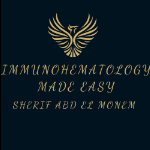Reputation Activity
-
 Bet'naSBB reacted to Malcolm Needs in Maternal alloantibody, not detected in baby - how long for antigen negative unitsIt is incredibly rare for anti-N to be an alloantibody, unless the individual is M+N-, and also S-s-U-. This is because the amino acids that characterise the N antigen on the Glycophorin A molecule (leucine, serine, threonine, threonine, glutamic acid) are identical to the amino acids that characterise the 'N' antigen on the Glycophorin B molecule.
Bet'naSBB reacted to Malcolm Needs in Maternal alloantibody, not detected in baby - how long for antigen negative unitsIt is incredibly rare for anti-N to be an alloantibody, unless the individual is M+N-, and also S-s-U-. This is because the amino acids that characterise the N antigen on the Glycophorin A molecule (leucine, serine, threonine, threonine, glutamic acid) are identical to the amino acids that characterise the 'N' antigen on the Glycophorin B molecule.
Is the lady of Black ethnicity by any chance? If not, to be N Negative AND 'N' Negative would be almost unique.
This suggests to me that the anti-N reported to be in the maternal circulation by the other hospital may well have been an auto-antibody, and would almost certainly be sub-clinical in its significance. In such a case, I would not bother with performing genotyping of the baby's N type. However, as far as Rh, K, etc, I would certainly suggest that antigen negative blood is given to the baby, and I certainly WOULD perform foetal genotyping (see my answer to Cliff above).
-
 Bet'naSBB reacted to John C. Staley in Maternal alloantibody, not detected in baby - how long for antigen negative unitsCouple of questions for clarification. What is the specificity of the known Alloantibody? "Baby is born and our testing shows negative antibody screen." Was this AB screen done on mom or baby? If on the baby, was a current ab screen performed on mom and if so what was the results? Was a DAT performed on the baby? If so, what was the result? If not, why not? Thanks
Bet'naSBB reacted to John C. Staley in Maternal alloantibody, not detected in baby - how long for antigen negative unitsCouple of questions for clarification. What is the specificity of the known Alloantibody? "Baby is born and our testing shows negative antibody screen." Was this AB screen done on mom or baby? If on the baby, was a current ab screen performed on mom and if so what was the results? Was a DAT performed on the baby? If so, what was the result? If not, why not? Thanks
-
 Bet'naSBB got a reaction from AuntiS in Plasma transfusionsMy question would be - how strong was the pre-transfusion reactivity? If it was only 1-2+ in SP / and the patient isn't a "larger" person, I personally would suspect that the antibody titer was diluted to such a degree that SP did not pick it up anymore....... (but I REALLY don't like SP.....it's just too wishy-washy.....JMHO)
Bet'naSBB got a reaction from AuntiS in Plasma transfusionsMy question would be - how strong was the pre-transfusion reactivity? If it was only 1-2+ in SP / and the patient isn't a "larger" person, I personally would suspect that the antibody titer was diluted to such a degree that SP did not pick it up anymore....... (but I REALLY don't like SP.....it's just too wishy-washy.....JMHO)
-
 Bet'naSBB reacted to jojo808 in Need AdviceMy greatest apology for leaving you all hanging. We've been so incredibly busy and short-staffed that I could not even think about anything else but trying to finish up my daily duties. Anyway, seems that the patient also had an impella device that had to be "adjusted" and I believe that corrected the hemolysis. I'm only reading the responses today (2 weeks later)☹️so hats off to you all who thought mechanical causes. I would have not thought that the device would be that far-off to cause the gross hemolysis we saw. We do see slight hemolysis with impella devices but not like this one. I guess never say never. Thank you all for your responses.
Bet'naSBB reacted to jojo808 in Need AdviceMy greatest apology for leaving you all hanging. We've been so incredibly busy and short-staffed that I could not even think about anything else but trying to finish up my daily duties. Anyway, seems that the patient also had an impella device that had to be "adjusted" and I believe that corrected the hemolysis. I'm only reading the responses today (2 weeks later)☹️so hats off to you all who thought mechanical causes. I would have not thought that the device would be that far-off to cause the gross hemolysis we saw. We do see slight hemolysis with impella devices but not like this one. I guess never say never. Thank you all for your responses.
-
 Bet'naSBB got a reaction from Yanxia in Eliminating Immediate spin for cold agglutininsAt our facility, we have to do a cold adsorption IF the cold auto interferes with the reverse and/or ISXM. Since testing with "neat" plasma is our standard of practice, we would still report the XM as incompatible and send it out with a release stating the incompatibility was due to an autoantibody. We are not "allowed" to prewarm away IS reactions. 🥶 IF we prewarm - it's only if the cold has a high thermal amplitude and causes interference after 37deg incubation / antiglobulin phase...........but that's just us.........
Bet'naSBB got a reaction from Yanxia in Eliminating Immediate spin for cold agglutininsAt our facility, we have to do a cold adsorption IF the cold auto interferes with the reverse and/or ISXM. Since testing with "neat" plasma is our standard of practice, we would still report the XM as incompatible and send it out with a release stating the incompatibility was due to an autoantibody. We are not "allowed" to prewarm away IS reactions. 🥶 IF we prewarm - it's only if the cold has a high thermal amplitude and causes interference after 37deg incubation / antiglobulin phase...........but that's just us.........
-
 Bet'naSBB got a reaction from Ally in Blind Samples/ CompetencyWe use our CAP samples AFTER the results have been submitted and results have been received from CAP.
Bet'naSBB got a reaction from Ally in Blind Samples/ CompetencyWe use our CAP samples AFTER the results have been submitted and results have been received from CAP.
We just finished assigning a BUNCH of "Internal Assessments" and "Method Comparisons" using our first batch of CAPs that we'd already received our results for. All these count as "blinds" for the staff. Instead of making 1 tech do the whole survey, we give each assignee one sample to do and then compare their results with those expected by CAP. works great!
For FMH, we get two CAP "TMCAF" surveys per year. 1/2 the staff does the first and the other 1/2 the second so everyone gets a blind for FMH.
-
 Bet'naSBB got a reaction from applejw in Supervisor competency assessmentMy manager and myself (asst manager) both complete the same competency that the staff do in order to be able to be able to fill in at the bench if the need arises. "This year's" competency is "good" for next year's observations. It's hard to get done - but, we both feel it's valuable - and the staff seems to appreciate that we remain "competent" since previous management had no clue what went on at the bench....
Bet'naSBB got a reaction from applejw in Supervisor competency assessmentMy manager and myself (asst manager) both complete the same competency that the staff do in order to be able to be able to fill in at the bench if the need arises. "This year's" competency is "good" for next year's observations. It's hard to get done - but, we both feel it's valuable - and the staff seems to appreciate that we remain "competent" since previous management had no clue what went on at the bench....
Keeps us in the loop.
-
 Bet'naSBB got a reaction from Malcolm Needs in BloodBankTalk: RhD ProteinI just answered this question.
Bet'naSBB got a reaction from Malcolm Needs in BloodBankTalk: RhD ProteinI just answered this question.
My Score PASS
-
 Bet'naSBB got a reaction from Neil Blumberg in Gel vs tube for DARA patientsOnce our patients show panreactivity in GEL, we automatically switch them to PEG screens which are negative 95% of the time. We stop doing gel all together.
Bet'naSBB got a reaction from Neil Blumberg in Gel vs tube for DARA patientsOnce our patients show panreactivity in GEL, we automatically switch them to PEG screens which are negative 95% of the time. We stop doing gel all together.
We don't test with DTT treated cells until the PEG screen comes up pos. Then, if the screen is NEG with DTT treated cells, we give K neg units with a signed release.
-
 Bet'naSBB reacted to Loony in Gel vs tube for DARA patients@Bet'naSBB Thank you. This is what I think our workflow should be as well. I’ll consult with management.
Bet'naSBB reacted to Loony in Gel vs tube for DARA patients@Bet'naSBB Thank you. This is what I think our workflow should be as well. I’ll consult with management.
-
 Bet'naSBB got a reaction from Mabel Adams in Patient with anti-D, anti-C is negative with other reagent cells but incompatible with most units.when we see up the side reactions in gel (we call them train tracks) it usually ends up being a cold auto sort of antibody.
Bet'naSBB got a reaction from Mabel Adams in Patient with anti-D, anti-C is negative with other reagent cells but incompatible with most units.when we see up the side reactions in gel (we call them train tracks) it usually ends up being a cold auto sort of antibody.
we would run a DAT - Poly, IgG and Complement.......
run a cold screen (IS, RT, 4C)
most times the explanation is there in this kind of testing...........
other reason could be rouleaux -
either way we would switch to PEG here..........and notate in the patient's record to perform future testing in PEG.
-
 Bet'naSBB reacted to Ensis01 in FDA requirements for 2 people to issue blood products for transfusion.In this context two people means that one person is from the floor or OR (an RN for example) who brings a transfuse order, a physical piece of paper, for a specific patient to the lab. One person in the lab issues the relevant product to the RN. This issuing process therefore involves two people representing the two involved departments comparing the name, MR#, product type and product # and any other requirements (Irr, antigens etc.) prior to formal issue. This theoretically ensures no errors. That being said I have had an RN bring a valid transfuse order for a different patient to the one she wished to transfuse.
Bet'naSBB reacted to Ensis01 in FDA requirements for 2 people to issue blood products for transfusion.In this context two people means that one person is from the floor or OR (an RN for example) who brings a transfuse order, a physical piece of paper, for a specific patient to the lab. One person in the lab issues the relevant product to the RN. This issuing process therefore involves two people representing the two involved departments comparing the name, MR#, product type and product # and any other requirements (Irr, antigens etc.) prior to formal issue. This theoretically ensures no errors. That being said I have had an RN bring a valid transfuse order for a different patient to the one she wished to transfuse.
-
 Bet'naSBB got a reaction from Yanxia in Patient with anti-D, anti-C is negative with other reagent cells but incompatible with most units.when we see up the side reactions in gel (we call them train tracks) it usually ends up being a cold auto sort of antibody.
Bet'naSBB got a reaction from Yanxia in Patient with anti-D, anti-C is negative with other reagent cells but incompatible with most units.when we see up the side reactions in gel (we call them train tracks) it usually ends up being a cold auto sort of antibody.
we would run a DAT - Poly, IgG and Complement.......
run a cold screen (IS, RT, 4C)
most times the explanation is there in this kind of testing...........
other reason could be rouleaux -
either way we would switch to PEG here..........and notate in the patient's record to perform future testing in PEG.
-
 (This conversation is happening in the blood bank, next to the blood component fridge. 'T' is closely inspecting an RBCs bag.)
(This conversation is happening in the blood bank, next to the blood component fridge. 'T' is closely inspecting an RBCs bag.)
Characters:
'S': Someone who has been working in the blood bank for a while. 'T': Someone who just started working in the blood bank. T: Hey, 'S', I keep seeing these bags with the "IRRADIATED" sticker on them. I understand that something was done to the bag, but why do only certain bags need this? And what exactly does it mean for the blood?
S: Excellent question, 'T'! This is a very important safety step that we perform for specific patients. Let’s break it down step by step.
Blood irradiation simply means exposing cellular blood components—such as RBCs, Platelets, and Granulocytes—to a controlled and calculated dose of radiation, usually using gamma rays or X-rays.
T: Radiation? That sounds serious! Why do we do this?
S: Exactly! Don’t just do things blindly—try to understand the reason behind them!
This irradiation is an additional step we apply to blood components for a very important reason. What is it?
It’s to prevent something called:
Transfusion-Associated Graft-versus-Host Disease (TA-GVHD).
T: Graft-versus-Host… like what happens in transplants? Can that happen from just a regular blood transfusion?
S: Yes, exactly the same concept! Though thankfully, it’s quite rare. Blood components contain immune cells from the donor, specifically T lymphocytes.
In TA-GVHD, these donor T cells recognize the patient’s body as foreign and start attacking it. Normally, the patient’s immune system can handle these donor cells, but problems arise when:
The patient’s immune system is very weak and unable to fight back (due to certain diseases or treatments). The patient is on immunosuppressive drugs. The donor is a relative of the patient or the bag is HLA-matched. In this case, the patient’s body may not recognize the donor’s cells as foreign, allowing them to survive and proliferate, but at the same time, these donor cells attack the patient’s body. T: Got it, that makes sense. So, irradiation stops these T cells from attacking?
S: Exactly! Radiation damages the DNA of the T cells, preventing them from multiplying or launching an attack. This effectively neutralizes the risk of TA-GVHD.
T: So, who exactly needs irradiated blood?
S: Patients with weakened immune systems, as we just discussed. The key groups include:
Patients receiving intrauterine transfusions (before birth). Premature infants or low-birthweight newborns. Patients with congenital immunodeficiencies. Those undergoing stem cell or bone marrow transplants. Patients with certain cancers or those on strong immunosuppressive drugs (e.g., Fludarabine). Patients receiving granulocyte transfusions. Anyone receiving blood from a relative or an HLA-matched donor. T: Understood. So how is irradiation done in practice?
S: We place the blood bag in a specialized device called a blood irradiator, which delivers a precise dose:
U.S. standards: At least 25 Gy at the center of the bag and 15 Gy at any other part. European standards: Minimum of 25 Gy anywhere in the bag, but the allowed range can go up to 50 Gy. This dose destroys the T cells.
We also use indicator labels that change color to confirm the bag has been irradiated, and the machines are regularly checked to ensure they deliver the exact required dose.
T: Does irradiation affect the blood itself? Like its quality or how long we can store it (shelf life)?
S: Good point! Yes, it does have some effects, especially on Red Blood Cells (RBCs).
Irradiation causes slight damage to the RBC membrane, leading to increased potassium leakage and some cell breakdown during storage. Because of this, the shelf life of the blood bag may change. This is why we follow strict guidelines, typically based on:
American (AABB) guidelines. European guidelines. But most importantly, the policy of your specific institution. Shelf Life Rules for RBCs:
American Standards: Irradiation can be done at any time before the bag’s original expiration date. The new expiration date becomes: 28 days from the irradiation date OR the original expiration date, whichever comes first. Example:
An RBC bag has an original shelf life of 42 days. If irradiated on Day 10, the new expiration date will be Day 38 (10 + 28) since that’s earlier than Day 42. If irradiated on Day 20, adding 28 days would bring it to Day 48, which exceeds the original Day 42 expiration, so the bag will still expire on Day 42. European Standards: Irradiation must be done within the first 28 days from donation (older bags cannot be irradiated). The new expiration date becomes: 14 days from irradiation OR 28 days from donation, whichever comes first. Example:
If a bag is irradiated on Day 10, it will expire on Day 24 (10 + 14) since that’s earlier than Day 28 from donation. If irradiated on Day 20, adding 14 days brings it to Day 34, but since that’s past Day 28, the bag still expires on Day 28. T: Wow, that’s really precise! So the expiration date must be carefully checked after irradiation.
S: Absolutely! Ideally, we try to irradiate RBCs as close to transfusion as possible.
If an irradiated RBC bag isn’t transfused within ~24 hours, it’s often recommended to wash the bag before giving it to the patient. This is mainly to remove excess potassium that may have leaked.
T: What about platelets? Does their shelf life decrease too?
S: Luckily, no. Platelets tolerate irradiation much better.
They can be irradiated at any point within their shelf life and still keep their original expiration date.
T: One last question?
S: Ask away, my friend!
T: Doesn’t leukoreduction also prevent GVHD?
S: That’s a common question! Leukoreduction significantly reduces the number of white blood cells, but it doesn’t eliminate them completely. Some T cells may still remain in amounts that can cause TA-GVHD in high-risk patients.
That’s why leukoreduction is NOT considered a replacement for irradiation when the goal is to prevent TA-GVHD.
However, some newer pathogen inactivation technologies treat blood components to reduce infection risks, and these methods also disable T lymphocytes.
So, blood components that undergo pathogen reduction often don’t require irradiation to prevent TA-GVHD.
T: This is super useful, 'S'! Now that I understand why we irradiate blood and how it affects storage, everything is much clearer. It’s clearly a critical step for patient safety.
S: Exactly! It’s all about protecting patients with weakened immune systems.
And always keep asking questions, 'T'—that’s the best way to learn in the blood bank!
What’s this irradiation label on this bag?!!!
-
 Bet'naSBB got a reaction from bblover in Remote temperature monitoring for Blood Bank refrigeratorsformer management was a huge proponent of OVERKILL - so we have:
Bet'naSBB got a reaction from bblover in Remote temperature monitoring for Blood Bank refrigeratorsformer management was a huge proponent of OVERKILL - so we have:
REES system for doors and internal temps (temps are compared weekly to "manual" temps to assure all are within acceptable range)
Document temp of "built in" digital readout daily (High and low alarm checks quarterly)
have separate, digital thermometer probes measuring top and bottom temps, documented daily calibrated annually
AND, last but not least, a global tracker that shows temp and stores info so if there's any question, the logged info can be downloaded and printed. calibrated annually
no one will ever be able to say we weren't tracking our temps!
-
 Bet'naSBB got a reaction from Ally in Immunohematology Made Easy groupOf course, my facility is blocking the link.....
Bet'naSBB got a reaction from Ally in Immunohematology Made Easy groupOf course, my facility is blocking the link.....
Is this a web page? Could you private message me the link please?
TIA
-
 Bet'naSBB got a reaction from Sherif Abd El Monem in Immunohematology Made Easy groupOf course, my facility is blocking the link.....
Bet'naSBB got a reaction from Sherif Abd El Monem in Immunohematology Made Easy groupOf course, my facility is blocking the link.....
Is this a web page? Could you private message me the link please?
TIA
-
 Bet'naSBB got a reaction from kab1 in ABID Using Mixed Methodologies?We will dilute the 3% to 0.8% and run in gel but with 40 min incubation. We found when we validated the process, it was imperative that the cells be diluted according to Ortho's "recipe" to dilute cells. While validating, we saw some false negatives when the dilution was "eyeballed" and/or when only incubated for 15 minutes. We might take to another media in certain cases, but PEG is our first choice....we will take to tube in a few situations...Patient on DARA, apparent antibody to gel itself or, antibody to preservative in gel cells (everything pos, auto neg). In cases of the last scenario, we will often try diluting a 3% screen from a different manufacturer and run those cells in gel to see if it's the cells, or the gel.......usually if the AC is neg, it's the cells.
Bet'naSBB got a reaction from kab1 in ABID Using Mixed Methodologies?We will dilute the 3% to 0.8% and run in gel but with 40 min incubation. We found when we validated the process, it was imperative that the cells be diluted according to Ortho's "recipe" to dilute cells. While validating, we saw some false negatives when the dilution was "eyeballed" and/or when only incubated for 15 minutes. We might take to another media in certain cases, but PEG is our first choice....we will take to tube in a few situations...Patient on DARA, apparent antibody to gel itself or, antibody to preservative in gel cells (everything pos, auto neg). In cases of the last scenario, we will often try diluting a 3% screen from a different manufacturer and run those cells in gel to see if it's the cells, or the gel.......usually if the AC is neg, it's the cells.
We are a large academic med ctr, and are the "reference" lab for other smaller sister hospitals so we do have the advantage of having access to screens and panels from multiple manufacturers.
-
 Bet'naSBB got a reaction from Kelly Guenthner in ABID Using Mixed Methodologies?We will dilute the 3% to 0.8% and run in gel but with 40 min incubation. We found when we validated the process, it was imperative that the cells be diluted according to Ortho's "recipe" to dilute cells. While validating, we saw some false negatives when the dilution was "eyeballed" and/or when only incubated for 15 minutes. We might take to another media in certain cases, but PEG is our first choice....we will take to tube in a few situations...Patient on DARA, apparent antibody to gel itself or, antibody to preservative in gel cells (everything pos, auto neg). In cases of the last scenario, we will often try diluting a 3% screen from a different manufacturer and run those cells in gel to see if it's the cells, or the gel.......usually if the AC is neg, it's the cells.
Bet'naSBB got a reaction from Kelly Guenthner in ABID Using Mixed Methodologies?We will dilute the 3% to 0.8% and run in gel but with 40 min incubation. We found when we validated the process, it was imperative that the cells be diluted according to Ortho's "recipe" to dilute cells. While validating, we saw some false negatives when the dilution was "eyeballed" and/or when only incubated for 15 minutes. We might take to another media in certain cases, but PEG is our first choice....we will take to tube in a few situations...Patient on DARA, apparent antibody to gel itself or, antibody to preservative in gel cells (everything pos, auto neg). In cases of the last scenario, we will often try diluting a 3% screen from a different manufacturer and run those cells in gel to see if it's the cells, or the gel.......usually if the AC is neg, it's the cells.
We are a large academic med ctr, and are the "reference" lab for other smaller sister hospitals so we do have the advantage of having access to screens and panels from multiple manufacturers.
-
 Bet'naSBB got a reaction from Mabel Adams in ABID Using Mixed Methodologies?We will dilute the 3% to 0.8% and run in gel but with 40 min incubation. We found when we validated the process, it was imperative that the cells be diluted according to Ortho's "recipe" to dilute cells. While validating, we saw some false negatives when the dilution was "eyeballed" and/or when only incubated for 15 minutes. We might take to another media in certain cases, but PEG is our first choice....we will take to tube in a few situations...Patient on DARA, apparent antibody to gel itself or, antibody to preservative in gel cells (everything pos, auto neg). In cases of the last scenario, we will often try diluting a 3% screen from a different manufacturer and run those cells in gel to see if it's the cells, or the gel.......usually if the AC is neg, it's the cells.
Bet'naSBB got a reaction from Mabel Adams in ABID Using Mixed Methodologies?We will dilute the 3% to 0.8% and run in gel but with 40 min incubation. We found when we validated the process, it was imperative that the cells be diluted according to Ortho's "recipe" to dilute cells. While validating, we saw some false negatives when the dilution was "eyeballed" and/or when only incubated for 15 minutes. We might take to another media in certain cases, but PEG is our first choice....we will take to tube in a few situations...Patient on DARA, apparent antibody to gel itself or, antibody to preservative in gel cells (everything pos, auto neg). In cases of the last scenario, we will often try diluting a 3% screen from a different manufacturer and run those cells in gel to see if it's the cells, or the gel.......usually if the AC is neg, it's the cells.
We are a large academic med ctr, and are the "reference" lab for other smaller sister hospitals so we do have the advantage of having access to screens and panels from multiple manufacturers.
-
 Bet'naSBB reacted to applejw in ABID Using Mixed Methodologies?Can you convert the tube panel cells from 3% to 0.8% and test in gel? We primarily do that to run selected cells that are not already diluted to 0/8%
Bet'naSBB reacted to applejw in ABID Using Mixed Methodologies?Can you convert the tube panel cells from 3% to 0.8% and test in gel? We primarily do that to run selected cells that are not already diluted to 0/8%
-
 Bet'naSBB reacted to John C. Staley in IAT & Ab IDThat's interesting because I was a long time user of Immucor products. Thanks for looking that up. Now I know something I didn't know yesterday.
Bet'naSBB reacted to John C. Staley in IAT & Ab IDThat's interesting because I was a long time user of Immucor products. Thanks for looking that up. Now I know something I didn't know yesterday.
-
 Bet'naSBB reacted to Malcolm Needs in IAT & Ab IDColumn agglutination technology is an excellent technique, but does have a tendency to detect antibodies that react at temperatures well below 37oC, even after fairly prolonged incubation at 37oC. However, the fact that the blood group, including the "reverse grouping" is clear of atypical agglutination suggests that this may not necessarily be the case for this patient.
Bet'naSBB reacted to Malcolm Needs in IAT & Ab IDColumn agglutination technology is an excellent technique, but does have a tendency to detect antibodies that react at temperatures well below 37oC, even after fairly prolonged incubation at 37oC. However, the fact that the blood group, including the "reverse grouping" is clear of atypical agglutination suggests that this may not necessarily be the case for this patient.
Just to be on the safe side though, and if you can, I would either treat the plasma from the sample with rabbit erythrocyte stroma (which will adsorb out most "cold" agglutinins), treat the plasma with 0.01M dithiothreitol (which will denature the J-chains of IgM molecules, meaning that, although they can still sensitise the red cells, they are no longer able to agglutinate the red cells) or, and my personal favourite, is to pre-warm the plasma and red cells to 37oC before mixing, perform the IAT at strictly 37oC in glass tubes, wash with saline warmed to 37oC and use monospecific AHG. If any, or all, of these techniques lead to negative results, the chances are that the antibody is a clinically insignificant "cold" IgM antibody, such as an auto-anti-HI (given that the patient is group A, and the test cells are all group O)..
Failing the above, send a sample to a red cell reference laboratory.
I hope that helps a little bit.
-
 Bet'naSBB got a reaction from jshepherd in FDA Registrationagree with @Neil Blumberg. We courier blood / platelets to our off site infusion centers on a daily basis and also to our small sister facilities that might need products. none of them have a separate FDA registration. We also send out WB, Plasma and RBC's on neighboring county EMS units and our in house Air units and none of them need FDA registration. Our medical director checked with his FDA "connection" and they sent an email stating as such.
Bet'naSBB got a reaction from jshepherd in FDA Registrationagree with @Neil Blumberg. We courier blood / platelets to our off site infusion centers on a daily basis and also to our small sister facilities that might need products. none of them have a separate FDA registration. We also send out WB, Plasma and RBC's on neighboring county EMS units and our in house Air units and none of them need FDA registration. Our medical director checked with his FDA "connection" and they sent an email stating as such.
-
 Bet'naSBB got a reaction from Mabel Adams in Weird antibody in pregnancyAnti-Lw?
Bet'naSBB got a reaction from Mabel Adams in Weird antibody in pregnancyAnti-Lw?
Don't know much about it - but I'm pretty sure it "looks" like a D - but then it's not................just googled and found this:
when testing for anti-LW, a key step is to use enzyme-treated cells to confirm its presence by observing a reduced or absent reaction compared to untreated cells









